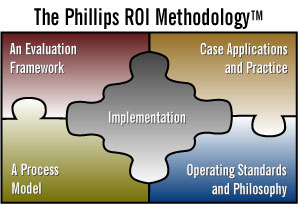
Today’s business community, and particularly the talent development community, are relying more on analytics to make decisions about programs and projects than ever before. Yet many people still ask: How do we ensure the right measures are taken and that the connection between investment in our people and the results achieved is clear?
The answer is clear: through the process of business alignment.
Business alignment ensures that investment drives relevant business results. Achieving business alignment requires that programs, projects, and initiatives be positioned for success, and then, evaluated accordingly. There are three phases to business alignment:
- Clarify stakeholder needs
- Develop measurable objectives
- Evaluate accordingly.
Clarify stakeholder needs
Initial alignment occurs when stakeholder needs are identified, which typically begins with the potential payoff for opportunities or problems. These payoff opportunities represent an organization’s opportunity to make money, save money, avoid costs, or to do some greater good.
Some payoff opportunities are obvious, such as a $1.5 million cost due to unwanted employee turnover. Other payoff opportunities are not so obvious, like the desire to build a great workplace.
Once clear about the potential payoff opportunities, the next step is to identify the specific business measures that, if improved, will position your organization to take advantage of the payoff opportunity.
For example, let’s say your company executives want the organization to become a green organization. The next step is to identify the business measures that need to improve to position your company as green. One relevant business measure may be the number of kilowatt-hours used per month.
Next, you will need to identify the performance needs, which are those behaviors or actions that if changed will improve the business measures. Using the green example, a performance need associated with kilowatt-hours might be employees leaving their computers on after they leave from work.
Then you will need to identify what employees need to know to change their behavior. In our example, one learning need may be that employees need to know the environmental impact associated with leaving computers on overnight.
Finally, identify the program, project, or initiative that will address stakeholder needs. By getting clear on the ultimate payoff first and working through the process—from business need, performance need, and learning need, to the solution—you’ve increased your chances of identifying the right investment opportunity given the goal at hand. More important, you’ve also established a basis for the measures to be taken.
Develop objectives
The second phase of alignment is through the development of objectives. Objectives correspond to stakeholder needs. Developing powerful program objectives at multiple levels positions the investment for success.
Objectives describe to designers and developers the intent of an initiative, giving them direction concerning which components to include. They also provide facilitators, team leaders, and program managers direction as they assist participants in preparing to change behavior, apply knowledge, and drive business outcomes.
Objectives representing stakeholder needs communicate the “what and why” of a program or project to participants. They keep impact objectives in constant focus, reminding participants of the ultimate reason for investing in a program.
Developing objectives that reflect stakeholder needs communicate to stakeholders that the program owner “gets it”—that he or she has paid attention to what is needed to support the organization’s success.
Objectives also set the stage for program evaluation, ensuring the right measures are taken and that results important to stakeholders are developed. Developing powerful objectives that reflect stakeholder needs is imperative to achieving business alignment.
Evaluate the program
The last phase in the alignment process is evaluation, where data are collected and analyzed. The final result is a reporting of the chain of impact that occurs, as people are involved in a program or project.
For example, you may have decided to implement a green campaign. Based on the information provided through the campaign, employees report agreement that going green is relevant and important. They indicate they know their role, why turning off their computer is important, and how much money they can save the company.
Three months after the campaign, you find that 90 percent of employees report they turn off their computer before leaving work. Upon checking the electric power bill, your organization’s facilities manager reports an average decrease of 5 percent in kilowatt-hours used per month based on three months of data. These findings are directly aligned with the stakeholder needs described earlier.
But the question remains: How much of that decrease in kilowatt-hours used is really due to the green campaign?
Your decision to answer, or not answer, this question determines the credibility of your results. While some people argue that you can’t isolate the effects of a program on results, we, along with others, argue that you can’t afford not to.
There are a variety of ways in which to isolate the effects of investments made in talent—from a control group arrangement and trend line analysis, to forecasting models and estimates adjusted for error. Jack Phillips was first to introduce the practice of isolating the effects of programs on results to the human resources industry in the early 1980s. Today, some consulting practices build their branding campaign around this one crucial step.
If you want to ensure that you take the right measures, analyze the right data, and make a clear connection to the business results you purport, follow the three steps to business alignment. Not only will you generate meaningful data, but also you will improve your chances for a positive ROI.
If you want learn more about business alignment and how to isolate the effects of your program on improved business measures, join us for Evaluate Training Programs using the ROI Methodology, or the ROI Certification Program.




